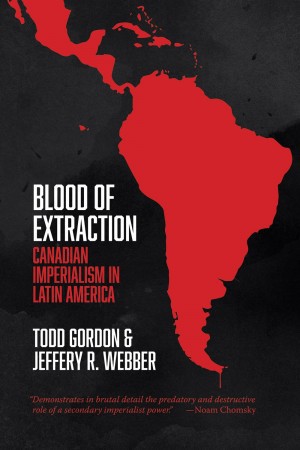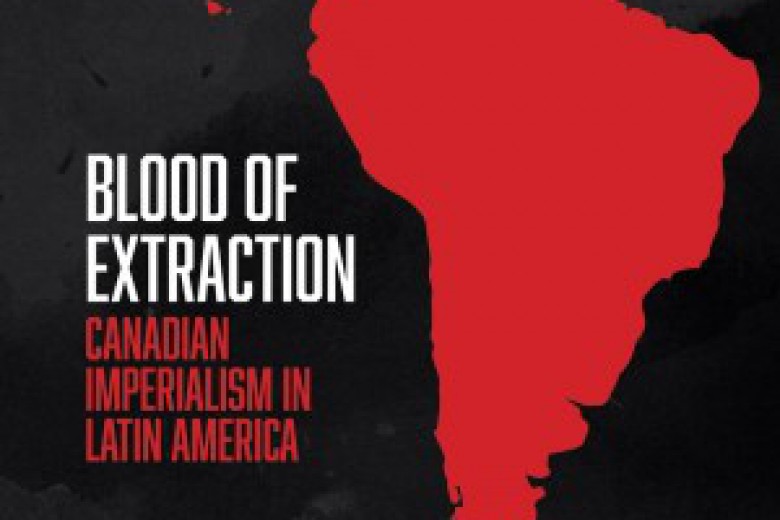
Linking our consumptive lives to the trails of destruction
Blood of Extraction is a comprehensive study of Canada’s economic entanglements with Latin America’s resource industries. By tracing Canadian capital investments and flows, the authors also sketch the influence of Canadian foreign policy upon Latin American state making, arguing that “transnational capitals root themselves in the nation-state opportunistically and flexibly.” This idea of flexibility is crucial to understanding foreign investments and extractivism today; at the same time, the flexibility of capital, military might, and new forms of disposability also leave social movements in a precarious position during a moment of radical retrenchment of leftist politics.
Gordon and Webber trace the rotating door of capital/resource investments and arms flows that overtly or covertly protect these interests. As the authors rightly point out, there is nothing new here. This embeddedness of capital and munitions flows is part of the historic arc of resource extraction and long legacies of colonial violence (especially violence upon bodies, lands, collective ideals, and alternative economic systems). Whether it is Canadian influence in Colombia (through extractive industries such as oil and mining) or Canadian transnational mining companies in Peru (gold), the authors sketch the ways in which multinational capital in mining plays a major role in perpetuating civil war in Colombia, and military and paramilitary terror in regions like Peru and Ecuador. In all cases, the long shadows cast by colonial violence (including the raping of lands, Indigenous women, and a way of life) come to the fore through resource extractivism tied to new forms of weapons – trade and militarism. As Gordon and Webber articulate in the Colombian context, “Once embedded in these environs, the violence that this capital requires as a regular feature of its accumulation process – to clear the land, to crush armed insurgents and to terrorize unarmed social movements opposed to extraction in their territories – quickly dispels any illusions that Canadian companies might be in any sense neutral bystanders in quintessentially Colombian armed conflict.” And here we see how the violence in the countryside is linked closely to capital flows: violence enables extractive capitalism to expand, to deepen, and even to flourish.
In all contexts of the Andes, the nefarious socio-ecological impact of extractivism has left a trail of ecological, social, and community destruction, which the authors link to David Harvey’s concept of “accumulation by dispossession.” Throughout the Andean region, we see how hydrocarbon exploration, mining for minerals, and expansion of agro-industrial monocropping has exacerbated a process of capital accumulation outwards; Canadian capitalists achieve massive profits while leaving devastating ecological impacts on the land as well as on local and regional water supplies. These disrupt ways of life and local economies around small-scale farming and fisheries. In all cases, questions of legality and state and capital embeddedness have pushed the territorial bounds for resource-based extraction into national parks, forest preserves, and deeper into the Amazon. Many of these efforts to expand into previously protected areas have resulted in Indigenous uprisings but have not ultimately slowed the influence of U.S. and, in this case, Canadian resource investments.
A few questions remain: a) how do we begin to create “humanistic” scales to measure the social, ecological, environmental impacts of extractivism and similar transnational practices just as capital investments are measured as net GDP growth? b) How do we capture in our analyses (beyond qualitative data) this trail of horror and destruction, and measure the urgency of these problems? c) How do we use these new metrics to hold U.S. and Canadian resource capitalists accountable?
Resource extractivism and the super-profitability of non-renewable fossil fuel industries is ever more concerning in an era of diminishing natural resources and the climate crisis. The Andean region – as a result of glacier melt, population density, and mismanagement of water supplies – is running out of water. Currently, in what is perhaps the worst drought the country has seen in 25 years, Bolivia is in a national state of emergency and under state-mandated water rationing in cities like La Paz. We will see more and more of these kinds of natural and human-made disasters in the coming years if there is not a centralized and effective state apparatus to deal with such problems.
I’d like to turn toward the state of social movements in the region during a moment of rightward political swing (from Colombia to Venezuela to Brazil). It is already clear that resource extraction regulation will decrease, states will be controlled by non-renewable fossil fuel giants, and U.S. and Canadian foreign influence will fuel military and paramilitary initiatives in the region. We have already seen the hyper-militarization of resource-based capitalism in places like Brazil, and subsequent repressions of protests and resistance. What does this mean for social movements in the region, for Indigenous peoples, and for alternative socio-ecologies? While sporadic resistance to mining is quite common in the Andes, no mass environmental movement has galvanized organized labor or united people across rural/urban divides or ethnic differences. But there seems to be a need to reconfigure movements across class, gender, race/ethnicity, and landlessness, to work independently of the centre-democratic Andean states (like those under Correa and Morales), and to map out a vision for sustainable alternatives and controls on foreign capital. None of this seems feasible, however, without a larger, more sustained movement. Canadian and U.S. climate and resource-based movements have been at the forefront of anti-pipeline, anti-tarsands resistance, and it’s important to consider the ways in which this is the right moment for anti-fossil fuel movements to cut across these geographic divides. The time is ripe to attack these companies on our home ground and rethink our economic articulation with them. How do our consumptive lives link back (politically, economically, and militaristically) to these trails of destruction in the Andes? What might North/South solidarity look like in this era?
Next:
Page 6: Todd Gordon and Jeffery Webber, Response
Previous:
Page 1. Todd Gordon and Jeffery Webber, Introduction
Page 2. Jerome Klassen, Canada and the Changing Structures of Global Power
Page 3. Simon Granovsky-Larsen, Backroom dealings and kick-back schemes
Page 4. Kyla Sankey, Accumulation by Dispossession, Expanded Reproduction, and Class Transformations in Latin America



